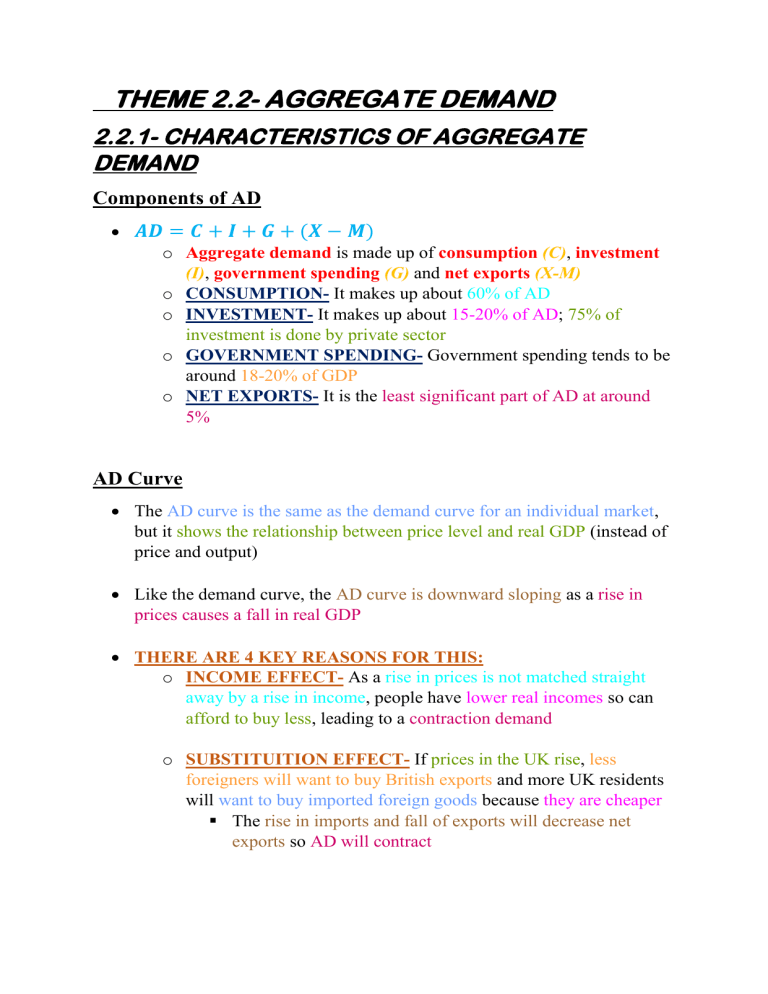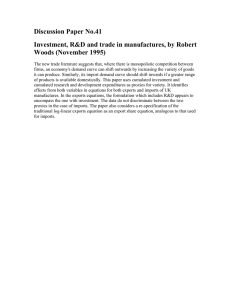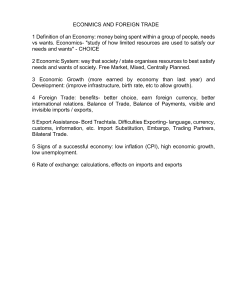
THEME 2.2- AGGREGATE DEMAND 2.2.1- CHARACTERISTICS OF AGGREGATE DEMAND Components of AD 𝑨𝑫 = 𝑪 + 𝑰 + 𝑮 + (𝑿 − 𝑴) o Aggregate demand is made up of consumption (C), investment (I), government spending (G) and net exports (X-M) o CONSUMPTION- It makes up about 60% of AD o INVESTMENT- It makes up about 15-20% of AD; 75% of investment is done by private sector o GOVERNMENT SPENDING- Government spending tends to be around 18-20% of GDP o NET EXPORTS- It is the least significant part of AD at around 5% AD Curve The AD curve is the same as the demand curve for an individual market, but it shows the relationship between price level and real GDP (instead of price and output) Like the demand curve, the AD curve is downward sloping as a rise in prices causes a fall in real GDP THERE ARE 4 KEY REASONS FOR THIS: o INCOME EFFECT- As a rise in prices is not matched straight away by a rise in income, people have lower real incomes so can afford to buy less, leading to a contraction demand o SUBSTITUITION EFFECT- If prices in the UK rise, less foreigners will want to buy British exports and more UK residents will want to buy imported foreign goods because they are cheaper The rise in imports and fall of exports will decrease net exports so AD will contract o REAL BALANCE EFFECT- A rise in prices will mean that the amount people have saved will no longer be worth as much and so will offer less security As a result, they will want to save more and so reduce their spending, causing a contraction in AD o INTEREST RATE EFFECT- Rising prices mean firms must pay their workers more, so there is higher demand for money If supply stays the same, the ‘price of money’ (interest rates) will rise because of this higher demand Higher interest rates mean that more people will save and less will borrow and will mean that businesses invest less, so AD will contract A movement along the AD curve is caused by a change in prices, caused by inflation or deflation A shift of the AD curve is caused by a change in any other variable o Like demand, a shift to the right represents an increase in AD and a shift to the left represents a fall in AD A fall in consumption will reduce AD o A fall in the rate of rise of consumption means that consumption is still rising, so AD will increase, but by not as much When prices increase, interest rates rise due to the interest rate effect, which causes a movement along the AD curve o If the government increases the interest rate, there is a shift in the AD curve 2.2.2- CONSUMPTION Disposable Income Disposable income is affected by government taxation as well as wages o It is the most important factor in determining the level of consumption as those who are earning a large income will be able to spend much more than those on a minimum wage o For most people, MPC will be positive but less than 1 Some people will have an MPC of more than one as they use borrowing or savings to fulfil the demand for goods which is higher than their increase in income 𝑴𝑷𝑪 = 𝑪𝒉𝒂𝒏𝒈𝒆 𝒊𝒏 𝒄𝒐𝒏𝒔𝒖𝒎𝒑𝒕𝒊𝒐𝒏 𝑪𝒉𝒂𝒏𝒈𝒆 𝒊𝒏 𝒊𝒏𝒄𝒐𝒎𝒆 𝑨𝑷𝑪 = 𝑻𝒐𝒕𝒂𝒍 𝒄𝒐𝒏𝒔𝒖𝒎𝒑𝒕𝒊𝒐𝒏 𝑻𝒐𝒕𝒂𝒍 𝒊𝒏𝒄𝒐𝒎𝒆 Relationship between savings and consumption: Savings is what is not spent out of income o An increase in consumption decreases savings so the same factors which affect consumption are those which affect savings, but in the opposite way 𝑴𝑷𝑺 = 𝑪𝒉𝒂𝒏𝒈𝒆 𝒊𝒏 𝒔𝒂𝒗𝒊𝒏𝒈𝒔 𝑪𝒉𝒂𝒏𝒈𝒆 𝒊𝒏 𝒊𝒏𝒄𝒐𝒎𝒆 𝑨𝑷𝑺 = 𝑻𝒐𝒕𝒂𝒍 𝒔𝒂𝒗𝒊𝒏𝒈𝒔 𝑻𝒐𝒕𝒂𝒍 𝒊𝒏𝒄𝒐𝒎𝒆 Influences on consumer spending INTEREST RATES- Most major expenditures are bought on credit, so the interest rate will affect the cost of the good for consumers o If interest rates are high, the price of the good will effectively be higher since more interest needs to be paid back and this will lead to a reduction in consumption o High interest rates increase mortgage repayments so reduce consumption o A rise in interest rates decreases the value of shares and so people experience a negative wealth effect CONSUMER CONFIDENCE- If people are confident about the future and expect pay rises, then they will continue or increase their spending o If they expect high levels of inflation in the future, they will buy now as it will be at a cheaper price, so consumption will increase o If they expect a recession and fear possible unemployment, consumption will decrease as people may save more WEALTH EFFECTS- People with greater wealth tend to have greater levels of consumption o The wealth effect is experienced when real house prices rise as owners now have more wealth, so they are more confident with spending They know that, if they go into financial difficulty, they could simply borrow more against the house, since their house is worth more than their current mortgage o Greater wealth will improve a consumer’s confidence and thus lead to greater spending 2.2.3- INVESTMENT * It is only seen as investment if real products are created so buying a share in a company would be saving, but buying new machinery is investment Gross and net investment Machinery depreciates (loses its value) over time as it wears out or gets used up Influences on Investment RATE OF ECONOMIC GROWTH- In a growing economy, there will be higher levels of investment as businesses would be confident about their investments and the higher demand would lead to a higher return rate on the investment o A growing economy needs more investment to cope with the higher levels of demand o If the same products and the same output is being produced every year, and demand is the same, investment will stay the same as firms only have to replace old machines o However, if the economy is growing, firms will need to increase investment to match the level of demand and vice-versa BUSINESS EXPECTATIONS AND CONFIDENCE- When businesses are confident about the future and expect future growth, investment will increase as they want to prepare for the future o If they are fearful of the future, they will not invest money in new ideas or machinery KEYNES AND “ANIMAL SPIRITS”- John Maynard Keynes used the term ‘animal spirits’ to describe the feeling of managers and owners of firms on whether their investment would be profitable o He argued that it is difficult to measure DEMAND FOR EXPORTS- If the world economy is booming, demand for exports is likely to increase and exporting firms’ investment is likely to increase to cope with this extra demand o This will have a knock-on effect and encourage other firms to increase their investment INTEREST RATES- Most investment is done through borrowing o High interest rates mean that borrowing is more expensive, so a business needs to be more confident of good profits to cover the extra costs of borrowing o A rise in interest rates increases the opportunity cost of a business using retained profits as they can get higher interest payments than before ACCESS TO CREDIT- Investment will be lower when an investment has a high risk attached to it, as it means there will be less access to credit and interest rates will be higher o In recessions, it is more difficult to access credit as risks are higher and banks become more risk aware, fearing firms will not be able to pay the money back INFLUENCE OF GOVERNMENT AND REGULATIONSGovernments can encourage investment by their own policy decisions o Regulations also affects investment as a highly regulated economy tends to see less investment as regulation increases the cost and time taken to invest, such as planning regulations 2.2.4- GOVERNMENT EXPENDITURE * The government has a significant part to play in the level of AD, through spending * The impact of a rise in government spending depends on the changes in tax: If government spending and tax rise by the same amount, there is likely to be no overall increase in demand as people have less disposable income (C decreases but G increases) Influences on Government Expenditure TRADE CYCLE- Decisions over government expenditure may be made to manage AD and regulate the trade cycle o In a recession, the government may increase spending to increase demand to reduce unemployment (they automatically spend more on unemployment benefits) o During booms, the government may decrease spending to decrease demand and reduce inflation FISCAL POLICY- Some government spending is fixed from year to year, for example, schools must be funded, and pensions must be paid o However, governments can vary what they spend each year, and this is set out in their budget o The level of government spending depends on what they lay out in their fiscal policy 2.2.5- NET TRADE * Exporting goods abroad brings money into the country as there is an increase in AD, whilst importing goods means money leaves the country Influence on net trade balance REAL INCOME- When real income in the UK is high, there are increased imports as people demand more goods and services o The UK is unable to meet the consumers’ needs so net trade decreases o However, if an increase in real income is due to export-led growth, net trade will increase EXCHANGE RATES- A strong pound (when the pound is worth lots in comparison to other countries) makes imports cheap and exports dear because it costs foreigners more to buy pounds with their local currency o As a result, imports will increase and exports will decrease, so net trade will decrease, but it depends on the elasticity of imports and exports o If imports are price elastic, a rise in price will cause a large fall in demand, so the value of imports will fall and vice-versa o If exports are price elastic, a rise in price will cause a large fall in demand, so the value of exports will fall and vice-versa STATE OF THE WORLD ECONOMY- If the UK’s main export country is doing well, the UK exports are likely to rise, so net trade is likely to rise o The effect of the state of the world economy is dependent on which countries are doing well and the trade relationship the UK has with them DEGREE OF PROTECTIONISM- Tariffs, quotas and technical barriers are introduced which makes it harder for producers from abroad to sell their goods in the UK o If there is high protectionism on UK exports in other countries, exports will decrease, as it will be harder for UK firms to sell their goods in other countries o If there is high protectionism on imports into the UK, imports will decrease o If the UK imposes protectionist measures, other countries are likely to retaliate and exports are likely to decrease o Free trade means that net trade will be a more significant part of AD NON-PRICE FACTORS- Two non-price factors which affect net trade are quality/ design and marketing o If UK goods are of a higher quality and design, exports will be high as foreign demand for UK goods will increase and imports will decrease as people will buy the British goods instead of foreign goods, which means net trade will increase o If UK goods are well marketed, people will have a stronger desire to buy British goods, so exports will increase and imports will decrease, so net trade will increase o Strong quality/design and marketing will mean that British exports are likely to be more inelastic




